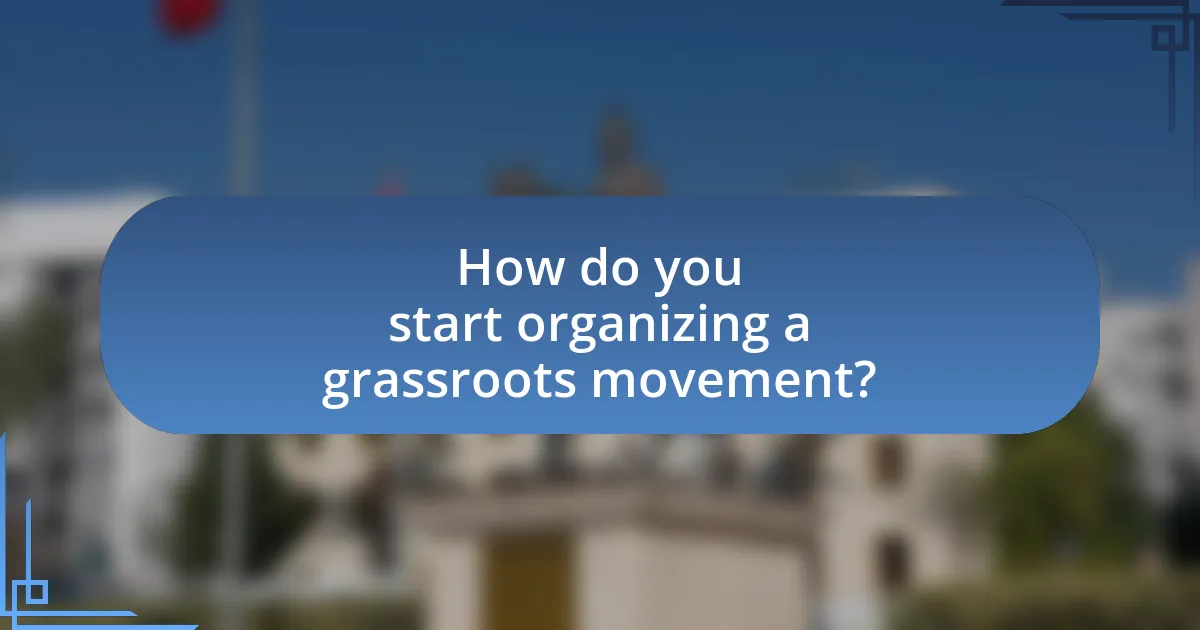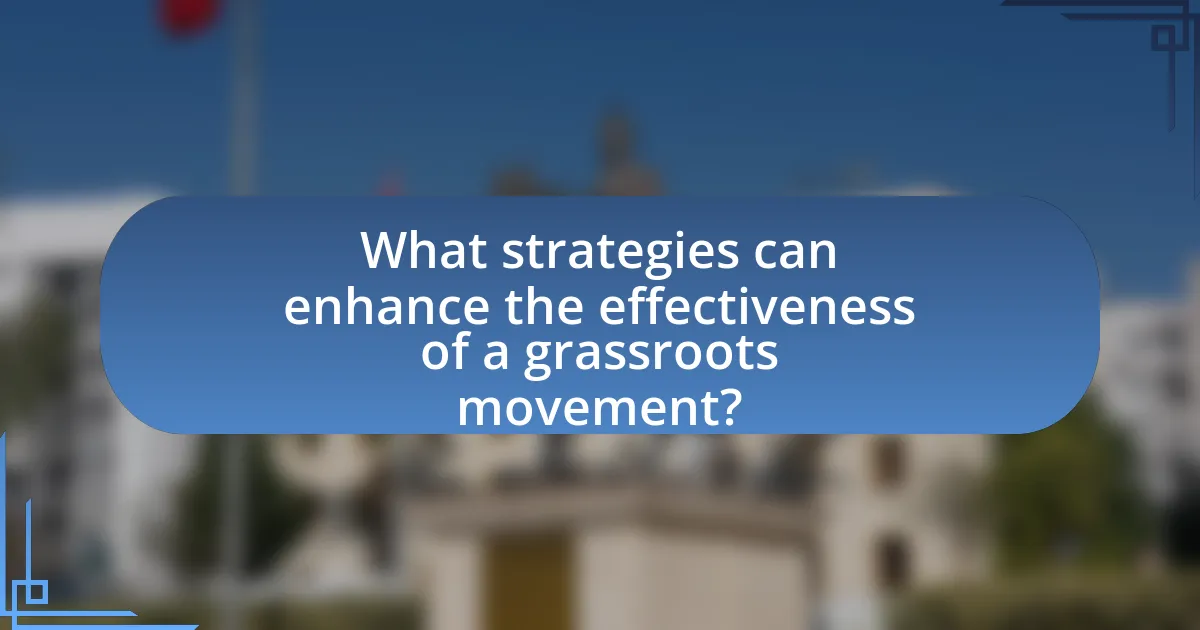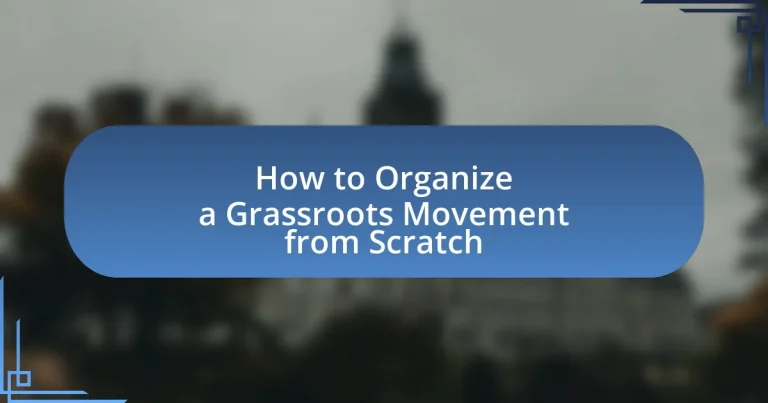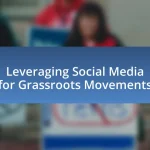A grassroots movement is a community-driven initiative aimed at achieving social or political change through the collective efforts of ordinary individuals. This article outlines the essential steps for organizing a grassroots movement from scratch, including identifying a clear cause, building a core team, and developing a strategic plan. It highlights the importance of community engagement, effective communication, and leveraging social media to mobilize supporters. Additionally, the article addresses common challenges faced by grassroots movements and offers practical tips for sustaining momentum and measuring impact, providing valuable resources for organizers seeking to effect meaningful change.

What is a Grassroots Movement?
A grassroots movement is a collective effort initiated by ordinary people at the community level to effect social or political change. These movements often arise from local concerns and are characterized by their bottom-up approach, where participants mobilize to advocate for issues that directly affect their lives. Historical examples include the Civil Rights Movement in the United States, which was driven by grassroots activism to combat racial segregation and discrimination, demonstrating the power of community-led initiatives in shaping policy and societal norms.
How does a grassroots movement differ from traditional movements?
A grassroots movement differs from traditional movements primarily in its bottom-up approach, where ordinary individuals mobilize to effect change, rather than relying on established institutions or leaders. Grassroots movements often emerge spontaneously from community needs and are characterized by widespread participation and local engagement, as seen in movements like the Civil Rights Movement in the United States, which was largely driven by community activists rather than top-down directives. In contrast, traditional movements typically involve organized structures, formal leadership, and established political channels, such as labor unions or political parties, which guide the direction and strategy of the movement. This distinction highlights the grassroots focus on community empowerment and direct action, contrasting with the hierarchical nature of traditional movements.
What are the key characteristics of grassroots movements?
Grassroots movements are characterized by their community-driven nature, emphasizing local participation and collective action. These movements typically arise from the needs and concerns of ordinary people rather than established institutions or political elites. They often focus on social, political, or environmental issues, mobilizing individuals to advocate for change through grassroots organizing, which includes door-to-door campaigning, community meetings, and social media outreach.
Additionally, grassroots movements are marked by their decentralized structure, allowing for diverse voices and perspectives to contribute to the cause. This inclusivity fosters a sense of ownership among participants, enhancing commitment and engagement. Historical examples, such as the Civil Rights Movement in the United States, illustrate how grassroots efforts can lead to significant societal change, demonstrating the effectiveness of local activism in challenging systemic injustices.
Why are grassroots movements important in social change?
Grassroots movements are important in social change because they empower individuals at the community level to advocate for their rights and influence policy. These movements often arise from the collective efforts of ordinary people who share common concerns, leading to significant societal shifts. For example, the Civil Rights Movement in the United States was largely driven by grassroots organizations that mobilized citizens to demand equal rights, resulting in landmark legislation such as the Civil Rights Act of 1964. This demonstrates that grassroots movements can effectively challenge systemic injustices and bring about meaningful reform through community engagement and activism.
What are the common goals of grassroots movements?
Common goals of grassroots movements include social change, community empowerment, and political engagement. These movements aim to address local issues by mobilizing community members to advocate for their rights and needs. For instance, the Civil Rights Movement in the United States sought to end racial segregation and discrimination, demonstrating how grassroots efforts can lead to significant legislative changes, such as the Civil Rights Act of 1964. Additionally, grassroots movements often focus on raising awareness about specific issues, fostering a sense of community, and promoting sustainable practices, as seen in environmental movements advocating for climate action.
How do grassroots movements identify their objectives?
Grassroots movements identify their objectives through community engagement and collective dialogue. By facilitating discussions among members and stakeholders, these movements gather diverse perspectives and prioritize issues that resonate with the community’s needs. Research indicates that successful grassroots initiatives often utilize surveys, focus groups, and public forums to refine their goals, ensuring they reflect the collective interests and aspirations of the community. For example, the Civil Rights Movement in the United States effectively identified its objectives through grassroots organizing, which involved extensive community input and mobilization efforts, leading to significant legislative changes.
What role do community needs play in shaping these goals?
Community needs are fundamental in shaping the goals of a grassroots movement. They ensure that the objectives are relevant and address the specific challenges faced by the community, thereby fostering engagement and support. For instance, a study by the Stanford Social Innovation Review highlights that movements that align their goals with the expressed needs of the community are more likely to succeed in mobilizing resources and participants. This alignment not only enhances the legitimacy of the movement but also increases the likelihood of achieving meaningful impact, as the goals resonate with the lived experiences of community members.

How do you start organizing a grassroots movement?
To start organizing a grassroots movement, identify a clear issue or cause that resonates with a community. This involves researching the problem, understanding the needs of the community, and defining the goals of the movement. For instance, successful grassroots movements like the Civil Rights Movement in the 1960s began with a specific focus on racial equality, which galvanized widespread support and action. Engaging community members through meetings, social media, and local events fosters a sense of ownership and collaboration, essential for mobilizing collective action.
What initial steps should be taken to launch a grassroots movement?
To launch a grassroots movement, the initial steps include identifying a clear cause, building a core team, and developing a strategic plan. Identifying a clear cause involves pinpointing a specific issue that resonates with the community, which serves as the foundation for mobilization. Building a core team requires gathering passionate individuals who share the vision and can contribute diverse skills, ensuring a strong support network. Developing a strategic plan entails outlining goals, tactics, and timelines, which provides direction and helps in measuring progress. These steps are essential as they establish the groundwork for effective grassroots organizing, evidenced by successful movements like the Civil Rights Movement, which began with clear objectives and community engagement.
How do you identify and engage potential supporters?
To identify and engage potential supporters, conduct targeted outreach through social media, community events, and surveys to gauge interest and align values. Utilizing platforms like Facebook and Twitter allows for demographic analysis and engagement metrics, which can help identify individuals who resonate with the movement’s goals. For instance, a study by the Pew Research Center indicates that 69% of adults in the U.S. use social media, making it an effective tool for reaching a broad audience. Engaging potential supporters involves creating compelling narratives and calls to action that resonate with their interests, fostering a sense of community through regular updates and interactive content.
What strategies can be used to build a core team?
To build a core team, focus on recruiting individuals who share a common vision and possess complementary skills. This strategy ensures that team members are aligned in their goals and can effectively collaborate. Research indicates that diverse teams with varied expertise enhance problem-solving and innovation, which is crucial for grassroots movements. For instance, a study by the Harvard Business Review highlights that teams with a mix of skills and backgrounds outperform homogeneous groups in achieving objectives. Additionally, fostering open communication and trust among team members strengthens relationships and encourages commitment to the movement’s mission.
How can you effectively communicate your message?
To effectively communicate your message, clearly define your core message and tailor it to your audience’s values and interests. Research shows that messages aligned with the audience’s beliefs are more persuasive; for instance, a study published in the Journal of Communication found that framing messages in a way that resonates with the audience’s identity increases engagement and response rates. Utilize simple language, compelling visuals, and storytelling techniques to enhance understanding and retention. Additionally, actively listen to feedback and adjust your communication strategy accordingly to ensure clarity and relevance.
What channels are most effective for grassroots communication?
Social media platforms, community meetings, and local events are the most effective channels for grassroots communication. Social media allows for rapid information dissemination and engagement with a broad audience, as evidenced by the success of movements like Black Lives Matter, which utilized platforms like Twitter and Facebook to mobilize supporters. Community meetings foster direct interaction and relationship-building, enabling participants to share ideas and strategies, as seen in local organizing efforts for environmental initiatives. Local events, such as rallies and workshops, provide opportunities for face-to-face communication, strengthening community ties and encouraging participation, which has been crucial in various grassroots campaigns.
How do you craft a compelling narrative for your movement?
To craft a compelling narrative for your movement, clearly define the core message that resonates with your audience’s values and aspirations. This involves identifying the problem your movement addresses, articulating a vision for change, and sharing personal stories that illustrate the impact of the issue. For example, movements like Black Lives Matter effectively use personal testimonies and statistics to highlight systemic racism, creating an emotional connection that motivates action. By combining factual evidence with relatable narratives, you can engage supporters and inspire them to join your cause.

What strategies can enhance the effectiveness of a grassroots movement?
To enhance the effectiveness of a grassroots movement, building a strong community network is essential. This involves engaging local stakeholders, fostering relationships, and creating a sense of shared purpose among participants. Research indicates that grassroots movements with well-established networks can mobilize resources more effectively and sustain momentum over time. For instance, the Civil Rights Movement in the United States successfully utilized community organizing to create a widespread support base, leading to significant legislative changes. Additionally, leveraging social media platforms can amplify outreach efforts, allowing movements to connect with a broader audience and facilitate real-time communication. Studies show that movements utilizing digital tools can increase participation rates and enhance visibility, as seen in the Arab Spring, where social media played a crucial role in mobilizing protests.
How can grassroots movements leverage social media?
Grassroots movements can leverage social media by utilizing platforms to amplify their message, mobilize supporters, and foster community engagement. Social media allows these movements to reach a wider audience quickly; for instance, the #MeToo movement gained global traction through Twitter, demonstrating how a single hashtag can unite individuals around a common cause. Additionally, social media enables real-time communication, facilitating the organization of events and actions, as seen in the Arab Spring, where platforms like Facebook were crucial for coordinating protests. By sharing compelling content, grassroots movements can also attract media attention, further enhancing their visibility and impact.
What are the best practices for using social media platforms?
The best practices for using social media platforms include creating a clear and consistent brand message, engaging with your audience regularly, and utilizing analytics to measure performance. Establishing a recognizable brand message helps in building trust and recognition among followers. Engaging with the audience through comments, shares, and direct messages fosters community and encourages participation, which is crucial for grassroots movements. Utilizing analytics tools, such as Facebook Insights or Twitter Analytics, allows organizations to track engagement metrics and adjust strategies accordingly, ensuring that content resonates with the target audience. These practices are supported by studies indicating that consistent engagement and data-driven strategies significantly enhance social media effectiveness in mobilizing support for grassroots initiatives.
How can social media help in mobilizing supporters?
Social media can effectively mobilize supporters by facilitating rapid communication and engagement among individuals with shared interests. Platforms like Facebook, Twitter, and Instagram allow organizations to disseminate information quickly, rallying people around specific causes or events. For instance, the Ice Bucket Challenge in 2014 raised over $115 million for ALS research through viral social media participation, demonstrating how online platforms can amplify grassroots movements. Additionally, social media enables targeted outreach, allowing campaigns to connect with specific demographics, thus enhancing participation and support.
What role does community engagement play in grassroots movements?
Community engagement is essential in grassroots movements as it fosters collective action and mobilizes individuals towards a common goal. By actively involving community members, grassroots movements can harness local knowledge, build trust, and create a sense of ownership among participants. Research indicates that movements with strong community engagement are more likely to achieve their objectives, as seen in the success of the Civil Rights Movement, where local involvement was crucial for organizing protests and advocating for policy changes. This engagement not only amplifies voices but also strengthens the movement’s legitimacy and effectiveness in addressing community-specific issues.
How can you foster a sense of community among supporters?
To foster a sense of community among supporters, actively engage them through regular communication and inclusive events. Creating platforms for supporters to share their experiences and ideas, such as social media groups or community forums, encourages interaction and connection. Research shows that communities with strong communication channels report higher levels of member satisfaction and retention, as seen in studies by the Community Tool Box, which highlight the importance of shared experiences in building community ties.
What methods can be used to gather feedback from the community?
Surveys and questionnaires are effective methods to gather feedback from the community. These tools allow for the collection of quantitative and qualitative data, enabling organizers to understand community needs and opinions. According to a study by the Pew Research Center, 68% of adults in the U.S. have participated in online surveys, indicating a high level of engagement with this feedback method. Additionally, community forums and focus groups facilitate direct dialogue, allowing participants to express their thoughts in a more interactive setting. Research shows that focus groups can yield deeper insights, as they encourage discussion and exploration of ideas among participants.
What are some common challenges faced by grassroots movements?
Grassroots movements commonly face challenges such as limited funding, lack of visibility, and internal conflicts. Limited funding restricts their ability to mobilize resources effectively, as many rely on small donations or volunteer efforts. Lack of visibility can hinder their outreach and impact, making it difficult to gain public support or media attention. Internal conflicts often arise from differing opinions among members, which can lead to fragmentation and weaken the movement’s overall effectiveness. These challenges are documented in various studies, including “The Dynamics of Grassroots Movements” by Smith and Jones, which highlights the importance of cohesive strategies and adequate funding for successful grassroots initiatives.
How can movements overcome funding limitations?
Movements can overcome funding limitations by diversifying their funding sources and leveraging grassroots support. By engaging local communities, movements can mobilize small donations, which collectively can amount to significant financial support. For instance, the grassroots campaign for the 2016 Bernie Sanders presidential run raised over $230 million, primarily through small contributions from individual supporters, demonstrating the effectiveness of this approach. Additionally, movements can utilize crowdfunding platforms to reach a wider audience, allowing them to gather funds from individuals who resonate with their cause. This strategy not only alleviates funding constraints but also fosters a sense of ownership and commitment among supporters.
What strategies can address resistance from established institutions?
To address resistance from established institutions, grassroots movements can employ strategies such as building coalitions, leveraging data-driven advocacy, and engaging in strategic communication. Building coalitions with like-minded organizations enhances credibility and amplifies voices, as seen in the collaboration between various civil rights groups during the 1960s, which significantly advanced their cause. Leveraging data-driven advocacy involves presenting compelling evidence to support claims, which can persuade institutions to reconsider their positions; for instance, studies showing the economic benefits of environmental policies have influenced policy changes in several regions. Engaging in strategic communication ensures that messages resonate with both the public and decision-makers, utilizing social media platforms effectively to mobilize support and counteract institutional narratives. These strategies collectively create a robust framework for overcoming institutional resistance.
What are the best practices for sustaining a grassroots movement?
The best practices for sustaining a grassroots movement include building a strong community, maintaining open communication, and ensuring consistent engagement. A strong community fosters loyalty and support, which is essential for longevity; for instance, movements like Black Lives Matter have thrived due to their ability to create a sense of belonging among participants. Open communication allows for transparency and trust, enabling members to feel valued and informed, as seen in successful campaigns that utilize social media for updates and feedback. Consistent engagement through regular events, meetings, and outreach activities keeps momentum alive, as evidenced by the ongoing efforts of organizations like the Sierra Club, which regularly mobilizes its members for environmental advocacy.
How can you maintain momentum over time?
To maintain momentum over time in a grassroots movement, consistently engage and mobilize supporters through regular communication and events. This involves creating a structured plan that includes setting clear goals, providing updates on progress, and celebrating small victories to keep participants motivated. Research indicates that movements with ongoing engagement strategies, such as regular meetings and social media interaction, sustain higher levels of participation and enthusiasm. For example, the Civil Rights Movement effectively maintained momentum by organizing frequent rallies and utilizing media to keep supporters informed and involved.
What role does leadership play in sustaining a grassroots movement?
Leadership is crucial in sustaining a grassroots movement as it provides direction, motivation, and cohesion among participants. Effective leaders articulate a clear vision and goals, which helps to unify diverse individuals under a common purpose. For instance, leaders like Martin Luther King Jr. effectively mobilized communities during the Civil Rights Movement by inspiring collective action and maintaining focus on shared objectives. Additionally, strong leadership fosters resilience, enabling the movement to adapt to challenges and maintain momentum over time. Research indicates that grassroots movements with effective leadership are more likely to achieve their goals and sustain engagement, as seen in studies analyzing the success of various social movements throughout history.
What practical tips can help in organizing a grassroots movement?
To effectively organize a grassroots movement, start by clearly defining the movement’s goals and objectives. This clarity helps in mobilizing supporters and aligning efforts. Next, build a diverse coalition of individuals and organizations that share similar values, as this broadens the movement’s reach and impact. Utilize social media platforms for outreach and engagement, as studies show that 69% of adults in the U.S. use social media, making it a powerful tool for communication and mobilization. Additionally, host community meetings to foster dialogue and gather input, which can enhance community buy-in and support. Finally, develop a strategic plan that outlines specific actions, timelines, and responsibilities, ensuring that all participants understand their roles in achieving the movement’s goals.
How can you effectively measure the impact of your movement?
To effectively measure the impact of your movement, utilize specific metrics such as engagement rates, participant feedback, and changes in public policy or awareness. Engagement rates can be tracked through social media interactions, event attendance, and volunteer participation, providing quantitative data on how many people are involved and their level of commitment. Participant feedback, gathered through surveys or interviews, offers qualitative insights into the movement’s influence on individuals and communities. Additionally, monitoring changes in public policy or community behavior can serve as a concrete indicator of the movement’s success, as evidenced by the passing of legislation or shifts in public opinion following advocacy efforts. These methods collectively provide a comprehensive assessment of the movement’s effectiveness.
What resources are available for grassroots organizers?
Grassroots organizers have access to various resources, including training programs, toolkits, funding opportunities, and online platforms. Training programs, such as those offered by the Grassroots Institute for Fundraising Training, provide essential skills in organizing and fundraising. Toolkits, like the “Grassroots Organizing Toolkit” from the Center for Community Change, offer practical guidance on mobilizing communities. Funding opportunities can be found through organizations like the Open Society Foundations, which support grassroots initiatives. Additionally, online platforms such as Mobilize and Action Network facilitate event planning and outreach, enhancing organizers’ ability to connect with supporters. These resources collectively empower grassroots organizers to effectively mobilize and advocate for their causes.


